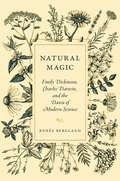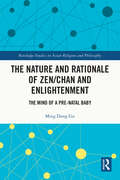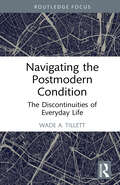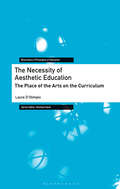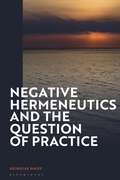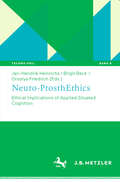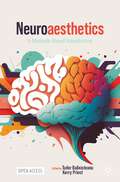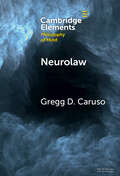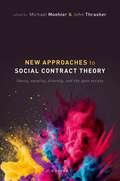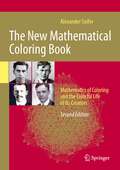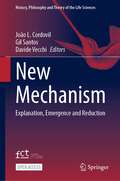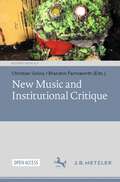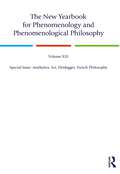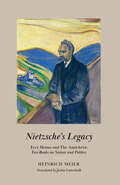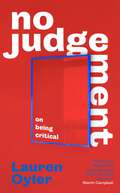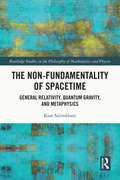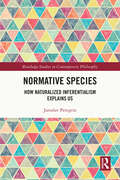- Table View
- List View
Natural Magic: Emily Dickinson, Charles Darwin, and the Dawn of Modern Science
by Renée BerglandA captivating portrait of the poet and the scientist who shared an enchanted view of natureEmily Dickinson and Charles Darwin were born at a time when the science of studying the natural world was known as natural philosophy, a pastime for poets, priests, and schoolgirls. The world began to change in the 1830s, while Darwin was exploring the Pacific aboard the Beagle and Dickinson was a student in Amherst, Massachusetts. Poetry and science started to grow apart, and modern thinkers challenged the old orthodoxies, offering thrilling new perspectives that suddenly felt radical—and too dangerous for women.Natural Magic intertwines the stories of these two luminary nineteenth-century minds whose thought and writings captured the awesome possibilities of the new sciences and at the same time strove to preserve the magic of nature. Just as Darwin&’s work was informed by his roots in natural philosophy and his belief in the interconnectedness of all life, Dickinson&’s poetry was shaped by her education in botany, astronomy, and chemistry, and by her fascination with the enchanting possibilities of Darwinian science. Casting their two very different careers in an entirely fresh light, Renée Bergland brings to life a time when ideas about science were rapidly evolving, reshaped by poets, scientists, philosophers, and theologians alike. She paints a colorful portrait of a remarkable century that transformed how we see the natural world.Illuminating and insightful, Natural Magic explores how Dickinson and Darwin refused to accept the separation of art and science. Today, more than ever, we need to reclaim their shared sense of ecological wonder.
The Nature and Rationale of Zen/Chan and Enlightenment: The Mind of a Pre-Natal Baby (Routledge Studies in Asian Religion)
by Ming Dong GuThis book initiates a paradigm shift away from Zen/Chan as quintessentially Buddhist and examines what makes Chan thought and practice unique and original through an interdisciplinary investigation of the nature and rationale of Chan and its enlightenment. Exploring how enlightenment is achieved through Chan practice and how this differs from other forms of Buddhism, the book offers an entirely new view of Chan that embraces historical scholarship, philosophical inquiry, textual analysis, psychological studies, Chan practice, and neuroscientific research and locates the core of Chan in its founder Huineng’s theory of no thinking which creatively integrates the Taoist ideas of zuowang (forgetting in seated meditation) and xinzhai (fast of heart-mind) with his personal experiences of enlightenment. It concludes that Chan is the crystallization of an innovative synthesis of Buddhism, Daoism, and Confucianism as well as other resources of somatic and spiritual cultivation, and enlightenment is a momentary return to the mental state of a baby before birth. This book will appeal to students and scholars of religion, philosophy and neuroscience. It will also offer new insights to thinkers, writers, artists, therapists and neuroscientists as well as those practicing Zen, Mindfulness and psychotherapy.
The Nature and Rationale of Zen/Chan and Enlightenment: The Mind of a Pre-Natal Baby (Routledge Studies in Asian Religion)
by Ming Dong GuThis book initiates a paradigm shift away from Zen/Chan as quintessentially Buddhist and examines what makes Chan thought and practice unique and original through an interdisciplinary investigation of the nature and rationale of Chan and its enlightenment. Exploring how enlightenment is achieved through Chan practice and how this differs from other forms of Buddhism, the book offers an entirely new view of Chan that embraces historical scholarship, philosophical inquiry, textual analysis, psychological studies, Chan practice, and neuroscientific research and locates the core of Chan in its founder Huineng’s theory of no thinking which creatively integrates the Taoist ideas of zuowang (forgetting in seated meditation) and xinzhai (fast of heart-mind) with his personal experiences of enlightenment. It concludes that Chan is the crystallization of an innovative synthesis of Buddhism, Daoism, and Confucianism as well as other resources of somatic and spiritual cultivation, and enlightenment is a momentary return to the mental state of a baby before birth. This book will appeal to students and scholars of religion, philosophy and neuroscience. It will also offer new insights to thinkers, writers, artists, therapists and neuroscientists as well as those practicing Zen, Mindfulness and psychotherapy.
Navigating the Postmodern Condition: The Discontinuities of Everyday Life
by Wade A. TillettDrawing on poststructuralist frameworks, this book examines the way to a radical acceptance of daily discontinuities and difference as it allows us to embrace life in the postmodern world.With each chapter exploring the human relationship with a disjunction in daily life, such as sleeping, forgetting, and multitasking, the author examines overlooked aspects of daily living as fresh data from which to analyze our condition. A phenomenological study of postmodern life, the book provides anecdotes of what it is like to live through these gaps and theorizes how we use these gaps. Using an arts-based methodology, the author also allows the work to mirror the discontinuities which it describes, interrupting the assumption of our lives as continuous and unitary in both form and content. Addressing the vast jumble of contradictions that is our daily experience in this contemporary world, it offers explanation through theory and anecdote and illustrates the path toward radical acceptance, which allows us to see ourselves as beautifully composed of fractures, gaps, and overflow. It will appeal to scholars, researchers, and postgraduate students with interests in poststructuralism, curriculum theory, and art-based research methods.
Navigating the Postmodern Condition: The Discontinuities of Everyday Life
by Wade A. TillettDrawing on poststructuralist frameworks, this book examines the way to a radical acceptance of daily discontinuities and difference as it allows us to embrace life in the postmodern world.With each chapter exploring the human relationship with a disjunction in daily life, such as sleeping, forgetting, and multitasking, the author examines overlooked aspects of daily living as fresh data from which to analyze our condition. A phenomenological study of postmodern life, the book provides anecdotes of what it is like to live through these gaps and theorizes how we use these gaps. Using an arts-based methodology, the author also allows the work to mirror the discontinuities which it describes, interrupting the assumption of our lives as continuous and unitary in both form and content. Addressing the vast jumble of contradictions that is our daily experience in this contemporary world, it offers explanation through theory and anecdote and illustrates the path toward radical acceptance, which allows us to see ourselves as beautifully composed of fractures, gaps, and overflow. It will appeal to scholars, researchers, and postgraduate students with interests in poststructuralism, curriculum theory, and art-based research methods.
Nazis, Islamic Antisemitism and the Middle East: The 1948 Arab War against Israel and the Aftershocks of World War II (Studies in Contemporary Antisemitism)
by Matthias KüntzelNazis, Islamic Antisemitism and the Middle East demonstrates the impact on the Arab world of Nazi ideology and propaganda in the 1930s and beyond. In 1937, with the brochure "Islam and Judaism," a new form of Jew-hatred came into the world: Islamic antisemitism. The Nazis did everything they could to anchor this new message of hate through their Arabic-language radio propaganda. The book sheds light on this hitherto unknown chapter of Germany's past. It presents new archive findings that show how the image of Jews in Islam changed between 1937 and 1948 under the influence of this propaganda and other Nazi activities. This fresh look at Middle East history allows for a more precise assessment of the present: What exactly is "Islamic antisemitism"? How is it currently manifesting itself in Germany and France? What makes it particularly dangerous? Only when we understand how strongly modern Middle East history is shaped by the aftermath of National Socialism will we be able to correctly interpret the hatred of Jews in this region and its echo among Muslims in Europe and develop adequate countermeasures. This volume will be of interest to those researching antisemitism, Nazi foreign policy and the political history of the Middle East.
Nazis, Islamic Antisemitism and the Middle East: The 1948 Arab War against Israel and the Aftershocks of World War II (Studies in Contemporary Antisemitism)
by Matthias KüntzelNazis, Islamic Antisemitism and the Middle East demonstrates the impact on the Arab world of Nazi ideology and propaganda in the 1930s and beyond. In 1937, with the brochure "Islam and Judaism," a new form of Jew-hatred came into the world: Islamic antisemitism. The Nazis did everything they could to anchor this new message of hate through their Arabic-language radio propaganda. The book sheds light on this hitherto unknown chapter of Germany's past. It presents new archive findings that show how the image of Jews in Islam changed between 1937 and 1948 under the influence of this propaganda and other Nazi activities. This fresh look at Middle East history allows for a more precise assessment of the present: What exactly is "Islamic antisemitism"? How is it currently manifesting itself in Germany and France? What makes it particularly dangerous? Only when we understand how strongly modern Middle East history is shaped by the aftermath of National Socialism will we be able to correctly interpret the hatred of Jews in this region and its echo among Muslims in Europe and develop adequate countermeasures. This volume will be of interest to those researching antisemitism, Nazi foreign policy and the political history of the Middle East.
The Necessity of Aesthetic Education: The Place of the Arts on the Curriculum (Bloomsbury Philosophy of Education)
by Laura D’OlimpioThe Necessity of Aesthetic Education is a manifesto. That which is experienced through engagement with art, through the many various and diverse art forms and media, is uniquely and essentially valuable to the lives of human beings. In order to fully appreciate and gain the most out of the arts, which offer a variety of aesthetic experience, there are concepts, skills and techniques integral to such understanding. In this book, Laura D'Olimpio argues that aesthetic education ought to be a compulsory part of education for all school-aged students, from pre-primary to high school, on the basis of its distinctive value. Such an argument is timely, given the so-called crisis in the arts and humanities, with declining student numbers in subjects that do not have a direct vocational correlative, and increased focus on science, engineering, technology and mathematics (STEM) subjects. As funding cuts increasingly slash the support for the arts, there is a need to argue for why the arts and arts education is valuable, for their own sake, as well as for the positive contributions they can and do make to society. Through critical engagement with a range of thinkers including Maxine Greene, John Dewey and Elliot Eisner, D'Olimpio offers a unique and important contribution to aesthetic education, and to research within philosophy of education.
Negative Hermeneutics and the Question of Practice
by Professor Nicholas DaveyHow do words and images function hermeneutically? How does hermeneutic practice work? Answering these questions and more, Nicholas Davey develops the hermeneutical foundations of creative practice. In doing so, he not only uncovers the significance of philosophical hermeneutics for the arts and the humanities, but defends the humanities as a whole from the current scepticism inspired by deconstruction and post-structuralism. Taking Gadamer's language ontology as its cue, this pioneering volume not only addresses certain weaknesses that Davey observes in Gadamer's thought but further takes Gadamerian thinking beyond Gadamer himself. In particular, Davey investigates the productive value of negativity that is central to hermeneutics and to wider spheres of creative learning. Advocating a renewed confidence in hermeneutics and the humanities, Negative Hermeneutics and the Question of Practice reveals how hermeneutical thinking provides a map of the dynamics within creative practice, eliminating the need for an externally imposed 'theory' of the arts.
Neuro-ProsthEthics: Ethical Implications of Applied Situated Cognition (Techno:Phil – Aktuelle Herausforderungen der Technikphilosophie #9)
by Jan-Hendrik Heinrichs Birgit Beck Orsolya FriedrichThe volume focusses on the ethical dimensions of the technological scaffold embedding human thought and action, which has been brought to attention of the cognitive sciences by situated cognition theories. There is a broad spectrum of technologies co-realising or enabling and enhancing human cognition and action, which vary in the degree of bodily integration, interactivity, adaptation processes, of reliance and indispensability etc. This technological scaffold of human cognition and action evolves rapidly. Some changes are continuous, some are eruptive. Technologies that use machine learning e.g. could represent a qualitative leap in the technological scaffolding of human cognition and actions. The ethical consequences of applying situated cognition theories to practical cases had yet to find adequate attention and are elucidated in this volume.
Neuroaesthetics: A Methods-Based Introduction
by Tudor Balinisteanu Kerry PriestThis open access neuroaesthetics textbook, the first in the world, is designed for teaching a semester module (14 meetings) to undergraduate/masters students from both the sciences and the humanities. Written in a style that appeals to humanities students without prior science training, and to science students without prior humanities training, the textbook contains 6 Units, material for an introductory class, and summative comments to be discussed in a closing meeting. Each Unit comprises an overview designed as student home reading, a lecture, and a lab. The labs contain detailed step-by-step instructions for running a basic experiment and analysing the collected data, that can be easily implemented in humanities and science departments alike. The textbook introduces students to philosophical considerations of neuroaesthetics topics in context of the history of empirical aesthetics, showcases experimental approaches to the empirical study of dance, the visual arts, and music, and supports hands-on training in experimental research methods.
Neurolaw (Elements in Philosophy of Mind)
by null Gregg D. CarusoNeurolaw is an area of interdisciplinary research on the meaning and implications of neuroscience for the law and legal practices. This Element addresses the potential contributions of neuroscience, and the brain sciences more generally, to criminal justice decision-making and policy. It distinguishes between three different areas and domains of investigation in neurolaw: assessment, intervention, and revision. The first concerns brain-based assessments, which may be used for predicting future violence, lie detection, judging legal insanity, and the like. The second concerns potential treatments and other interventions that aim at rehabilitating criminals and/or preventing crime before it occurs. The third investigates the ways that neuroscience may impact the law by changing or revising commonsense views about human nature and the causes of human action.
New Approaches to Social Contract Theory: Liberty, Equality, Diversity, and the Open Society
by Michael Moehler John ThrasherThis book features new approaches to social contract theory. Whereas traditional social contract theories and their adaptations in the twentieth century were developed for fairly homogeneous societies, societies in the twenty-first century often are characterized by conflicting first-order directives that stem from deep moral, political, religious, and cultural diversity. To address such diversity and the complexities of contemporary societies, new approaches (including formal approaches) to social contract theory have emerged that re-envision the social contract for a fragmented and sometimes polarized, yet interdependent social world. New social contract theory explores how, in a world of continuous disagreement on questions of justice, in particular the ideals of liberty and equality, society can not only progress, but also flourish and become more robust and open in its social fabric. This book brings together, for the first time, defenders and discussants of new social contract theory. It includes contributions by eminent and emerging scholars in this field. The book clarifies the distinct features of new social contract theory and provides a valuable starting point for discussion of this novel movement in social contract theory.
The New Mathematical Coloring Book: Mathematics of Coloring and the Colorful Life of Its Creators
by Alexander SoiferThe New Mathematical Coloring Book (TNMCB) includes striking results of the past 15-year renaissance that produced new approaches, advances, and solutions to problems from the first edition. A large part of the new edition “Ask what your computer can do for you,” presents the recent breakthrough by Aubrey de Grey and works by Marijn Heule, Jaan Parts, Geoffrey Exoo, and Dan Ismailescu. TNMCB introduces new open problems and conjectures that will pave the way to the future keeping the book in the center of the field. TNMCB presents mathematics of coloring as an evolution of ideas, with biographies of their creators and historical setting of the world around them, and the world around us.A new thing in the world at the time, TMCB I is now joined by a colossal sibling containing more than twice as much of what only Alexander Soifer can deliver: an interweaving of mathematics with history and biography, well-seasoned with controversy and opinion. –Peter D. Johnson, Jr.Auburn UniversityLike TMCB I, TMCB II is a unique combination of Mathematics, History, and Biography written by a skilled journalist who has been intimately involved with the story for the last half-century. …The nature of the subject makes much of the material accessible to students, but also of interest to working Mathematicians. … In addition to learning some wonderful Mathematics, students will learn to appreciate the influences of Paul Erdős, Ron Graham, and others.–Geoffrey ExooIndiana State UniversityThe beautiful and unique Mathematical coloring book of Alexander Soifer is another case of “good mathematics”, containing a lot of similar examples (it is not by chance that Szemerédi’s Theorem story is included as well) and presenting mathematics as both a science and an art…–Peter MihókMathematical Reviews, MathSciNetA postman came to the door with a copy of the masterpiece of the century. I thank you and the mathematics community should thank you for years to come. You have set a standard for writing about mathematics and mathematicians that will be hard to match.– Harold W. KuhnPrinceton UniversityI have never encountered a book of this kind. The best description of it I can give is that it is a mystery novel… I found it hard to stop reading before I finished (in two days) the whole text. Soifer engages the reader's attention not only mathematically, but emotionally and esthetically. May you enjoy the book as much as I did!– Branko GrünbaumUniversity of WashingtonI am in absolute awe of your 2008 book.–Aubrey D.N.J. de GreyLEV Foundation
New Mechanism: Explanation, Emergence and Reduction (History, Philosophy and Theory of the Life Sciences #35)
by João L. Cordovil Gil Santos Davide VecchiThis open access book addresses the epistemological and ontological significance as well as the scope of new mechanism. In particular, this book addresses the issues of what is "new" about new mechanism, the epistemological and ontological reasons underlying the adoption of mechanistic instead of other modelling strategies as well as the possibility of mechanistic explanation to accommodate a non-trivial notion of emergence. Arguably, new mechanism has been particularly successful in making sense of scientific practice in the molecular life sciences. But what about other sciences? This book enlarges the context of analysis, addressing the issue of the putative compatibility between the current ways of conceiving new mechanism and actual scientific practices in quantum physics, chemistry, biochemistry, developmental biology and the cognitive sciences.
New Music and Institutional Critique (Ästhetiken X.0 – Zeitgenössische Konturen ästhetischen Denkens)
by Christian Grüny Brandon FarnsworthWhile institutional critique has long been an important part of artistic practice and theoretical debate in the visual arts, it has long escaped attention in the field of music. This open access volume assembles for the first time an array of theoretical approaches and practical examples dealing with New Music’s institutions, their critique, and their transformations. For scholars, leaders, and practitioners alike, it offers an important overview of current developments as well as theoretical reflections about New Music and its institutions today. In this way, it provides a major contribution to the debate about the present and future of contemporary music.
The New Yearbook for Phenomenology and Phenomenological Philosophy: Volume 21, Special Issue, 2023: Aesthetics, Art, Heidegger, French Philosophy (New Yearbook For Phenomenology And Phenomenological Philosophy Ser.)
by Burt C. Hopkins Daniele De SantisVolume XXI Special Issue, 2023 Part 1: Phenomenological Perspectives on Aesthetics and Art Part 2: Heidegger and Contemporary French Philosophy Aim and Scope: The New Yearbook for Phenomenology and Phenomenological Philosophy provides an annual international forum for phenomenological research in the spirit of Husserl’s groundbreaking work and the extension of this work by such figures as Reinach, Scheler, Stein, Heidegger, Sartre, Levinas, Merleau-Ponty and Gadamer. Contributors: Liliana Albertazzi, Dimitris Apostolopoulos, Gabriele Baratelli, Anna Irene Baka, Irene Breuer, John Brough, Peer Bundgaard, Justin Clemens, Richard Colledge, Bryan Cooke, Françoise Dastur, Ivo De Gennaro, Natalie Depraz, Helena De Preester, Daniele De Santis, Madalina Diaconu, Arto Haapala, Robyn Horner, Erik Kuravsky, Donald Landes, Elisa Magri, Michelle Maiese, Regina-Nino Mion, Brian O’Connor, Costas Pagondiotis, Knox Peden, Constantinos Picolas, Hans Reiner Sepp, Jack Reynolds, Jon Roffe, Claude Romano, Maxine Sheets-Johnstone, Michela Summa, Panos Theodorou, Fotini Vassiliou, and Sanem Yazicioglu. Submissions: Manuscripts, prepared for blind review, should be submitted to the Editors (burt-crowell.hopkins@univ-lille3.fr and daniele.desantis@ff.cuni.cz) electronically via e-mail attachments.
The New Yearbook for Phenomenology and Phenomenological Philosophy: Volume 21, Special Issue, 2023: Aesthetics, Art, Heidegger, French Philosophy (New Yearbook For Phenomenology And Phenomenological Philosophy Ser.)
by Burt C. Hopkins Daniele De SantisVolume XXI Special Issue, 2023 Part 1: Phenomenological Perspectives on Aesthetics and Art Part 2: Heidegger and Contemporary French Philosophy Aim and Scope: The New Yearbook for Phenomenology and Phenomenological Philosophy provides an annual international forum for phenomenological research in the spirit of Husserl’s groundbreaking work and the extension of this work by such figures as Reinach, Scheler, Stein, Heidegger, Sartre, Levinas, Merleau-Ponty and Gadamer. Contributors: Liliana Albertazzi, Dimitris Apostolopoulos, Gabriele Baratelli, Anna Irene Baka, Irene Breuer, John Brough, Peer Bundgaard, Justin Clemens, Richard Colledge, Bryan Cooke, Françoise Dastur, Ivo De Gennaro, Natalie Depraz, Helena De Preester, Daniele De Santis, Madalina Diaconu, Arto Haapala, Robyn Horner, Erik Kuravsky, Donald Landes, Elisa Magri, Michelle Maiese, Regina-Nino Mion, Brian O’Connor, Costas Pagondiotis, Knox Peden, Constantinos Picolas, Hans Reiner Sepp, Jack Reynolds, Jon Roffe, Claude Romano, Maxine Sheets-Johnstone, Michela Summa, Panos Theodorou, Fotini Vassiliou, and Sanem Yazicioglu. Submissions: Manuscripts, prepared for blind review, should be submitted to the Editors (burt-crowell.hopkins@univ-lille3.fr and daniele.desantis@ff.cuni.cz) electronically via e-mail attachments.
Nietzsche's Legacy: "Ecce Homo" and "The Antichrist," Two Books on Nature and Politics
by Heinrich MeierA reappraisal of Ecce Homo and The Antichrist within Nietzsche’s oeuvre. Nietzsche's Legacy takes on the most challenging and misunderstood works in Nietzsche’s oeuvre to illuminate his view of what a philosopher is and what constitutes a philosophic life. Interpreting Ecce Homo and The Antichrist as twin books meant to replace the abandoned Will to Power project, Heinrich Meier recovers them from the stigma of Nietzsche’s late mental collapse, showing that these works are, above all, a lucid self-assessment. The carefully written pair contains both the highest affirmation—the Yes of the “revaluation of all values”—and the most resolute negation—the No to Christianity. How the Yes and the No go together, how the relation between nature and politics is to be determined, how Nietzsche’s intention is governing the political-philosophical double-face: this is the subject of Nietzsche’s Legacy, which opens up a new understanding of Nietzsche’s philosophy as a whole.
Nietzsche's Legacy: "Ecce Homo" and "The Antichrist," Two Books on Nature and Politics
by Heinrich MeierA reappraisal of Ecce Homo and The Antichrist within Nietzsche’s oeuvre. Nietzsche's Legacy takes on the most challenging and misunderstood works in Nietzsche’s oeuvre to illuminate his view of what a philosopher is and what constitutes a philosophic life. Interpreting Ecce Homo and The Antichrist as twin books meant to replace the abandoned Will to Power project, Heinrich Meier recovers them from the stigma of Nietzsche’s late mental collapse, showing that these works are, above all, a lucid self-assessment. The carefully written pair contains both the highest affirmation—the Yes of the “revaluation of all values”—and the most resolute negation—the No to Christianity. How the Yes and the No go together, how the relation between nature and politics is to be determined, how Nietzsche’s intention is governing the political-philosophical double-face: this is the subject of Nietzsche’s Legacy, which opens up a new understanding of Nietzsche’s philosophy as a whole.
No Judgement: On Being Critical
by Lauren OylerA brilliant and addictive collection of brand-new essays on modern culture - from 'the pre-eminent and most widely read critic of her generation' The Times Included as a 2024 highlight in the Observer, Stylist, the Skinny, BBC Online and the Independent 'Funny, insightful and bang on the money' Stylist--------------------------------------------I heard this crazy story, and I want you to know.It is the age of internet gossip; of social networks, repackaged ideas and rating everything out of five stars. Mega-famous celebrities respond with fury to critics who publish less-than-rapturous reviews of their work (and then delete their tweets); CEOs talk about reclaiming 'the power of vulnerability'; and in the world of fiction, writers eschew actually making things up in favour of 'always just talking about themselves'.In this blistering, irreverent and very funny first book of non-fiction, Lauren Oyler - one of the most trenchant, influential, and revelatory critics of her generation - takes on the bizarre particularities of our present moment in a series of interconnected essays about literature, the attention economy, gossip, the role of criticism and her own relentless, teeth-grinding anxiety.Illuminating and thought-provoking, by turns drily scathing and disarmingly open, No Judgement excavates the layers of psychology and meaning in how we communicate, tell stories and make critical judgements - to offer dazzling insights into how we live and think today.'Brisk, honest and soaring with élan' Naoise Dolan, author of The Happy Couple'Smart and unafraid and (thank God) funny. This is exactly what I want to read' Monica Heisey, author of Really Good, Actually'Oyler is the kind of dangerous contemporary writer we need more of' Niamh Campbell, author of We Were Young
The Non-Fundamentality of Spacetime: General Relativity, Quantum Gravity, and Metaphysics (Routledge Studies in the Philosophy of Mathematics and Physics)
by Kian SalimkhaniThis book argues that our current best theories of fundamental physics are best interpreted as positing spacetime as non-fundamental. It is written in accessible language and largely avoids mathematical technicalities by instead focusing on the key metaphysical and foundational lessons for the fundamentality of spacetime. According to orthodoxy, spacetime and spatiotemporal properties are regarded as fundamental structures of our world. Spacetime fundamentalism, however, faces challenges from speculative theories of quantum gravity – roughly speaking, the project of applying the lessons of quantum mechanics to gravitation and spacetime. This book demonstrates that the non-fundamentality of spacetime does not rely on speculative physics alone. Rather, one can give an interpretation of general relativity that supports some form of spacetime non-fundamentalism. The author makes the case for spacetime non-fundamentalism in three steps. First, he confronts the standard geometrical interpretation of general relativity with Brown and Pooley’s dynamical approach to relativity theory. Second, he considers an alternative derivation of the Einstein field equations, namely the classical spin-2 approach, and argues that it paves the way for a refined dynamical approach to general relativity. Finally, he argues that particle physics can serve as a continuity condition for the metaphysics of spacetime. The Non-Fundamentality of Spacetime will be of interest to scholars and advanced students working in philosophy of physics, philosophy of science, and metaphysics.
The Non-Fundamentality of Spacetime: General Relativity, Quantum Gravity, and Metaphysics (Routledge Studies in the Philosophy of Mathematics and Physics)
by Kian SalimkhaniThis book argues that our current best theories of fundamental physics are best interpreted as positing spacetime as non-fundamental. It is written in accessible language and largely avoids mathematical technicalities by instead focusing on the key metaphysical and foundational lessons for the fundamentality of spacetime. According to orthodoxy, spacetime and spatiotemporal properties are regarded as fundamental structures of our world. Spacetime fundamentalism, however, faces challenges from speculative theories of quantum gravity – roughly speaking, the project of applying the lessons of quantum mechanics to gravitation and spacetime. This book demonstrates that the non-fundamentality of spacetime does not rely on speculative physics alone. Rather, one can give an interpretation of general relativity that supports some form of spacetime non-fundamentalism. The author makes the case for spacetime non-fundamentalism in three steps. First, he confronts the standard geometrical interpretation of general relativity with Brown and Pooley’s dynamical approach to relativity theory. Second, he considers an alternative derivation of the Einstein field equations, namely the classical spin-2 approach, and argues that it paves the way for a refined dynamical approach to general relativity. Finally, he argues that particle physics can serve as a continuity condition for the metaphysics of spacetime. The Non-Fundamentality of Spacetime will be of interest to scholars and advanced students working in philosophy of physics, philosophy of science, and metaphysics.
Normative Species: How Naturalized Inferentialism Explains Us (Routledge Studies in Contemporary Philosophy)
by Jaroslav PeregrinThis book is about rules, and especially about human capability to create, maintain and follow rules, as a root of what makes us humans different from other animals. The leading idea is that scrutinizing this capability is able to tell us who we humans are and what kinds of lives we live. It elaborates Wilfrid Sellars' visionary observation that "to say that man is a rational animal, is to say that man is a creature not of habits, but of rules"; and it builds on the ideas of Sellars' and Brandom's inferentialism, in a novel naturalistic way. The main tenet of inferentialism is that our language games are essentially rule-governed and that meanings are inferential roles. Jaroslav Peregrin sees the task of reconciliation of inferentialism and naturalism as centered around the problem of naturalization of rules. He argues that the most primitive form of a rule is a cluster of normative attitudes. We humans are specific by our tendency assume peculiar attitudes to what we do, and to do so in a specific way, which turns the attitudes into "normative" ones. This self-reflective structure characterizes our ability to build systems of interconnected rules, which have come to constitute our natural niche. Furthermore, Peregrin shows how our most important system of rules—that constitutive of our language—helped to lead us to our current position of rule-following, ultra-social, rational, and discursive creatures. Normative Species will be of interest to scholars and advanced students working in philosophy of language, philosophy of mind, social ontology, cultural evolution, and cognitive science.
Normative Species: How Naturalized Inferentialism Explains Us (Routledge Studies in Contemporary Philosophy)
by Jaroslav PeregrinThis book is about rules, and especially about human capability to create, maintain and follow rules, as a root of what makes us humans different from other animals. The leading idea is that scrutinizing this capability is able to tell us who we humans are and what kinds of lives we live. It elaborates Wilfrid Sellars' visionary observation that "to say that man is a rational animal, is to say that man is a creature not of habits, but of rules"; and it builds on the ideas of Sellars' and Brandom's inferentialism, in a novel naturalistic way. The main tenet of inferentialism is that our language games are essentially rule-governed and that meanings are inferential roles. Jaroslav Peregrin sees the task of reconciliation of inferentialism and naturalism as centered around the problem of naturalization of rules. He argues that the most primitive form of a rule is a cluster of normative attitudes. We humans are specific by our tendency assume peculiar attitudes to what we do, and to do so in a specific way, which turns the attitudes into "normative" ones. This self-reflective structure characterizes our ability to build systems of interconnected rules, which have come to constitute our natural niche. Furthermore, Peregrin shows how our most important system of rules—that constitutive of our language—helped to lead us to our current position of rule-following, ultra-social, rational, and discursive creatures. Normative Species will be of interest to scholars and advanced students working in philosophy of language, philosophy of mind, social ontology, cultural evolution, and cognitive science.
